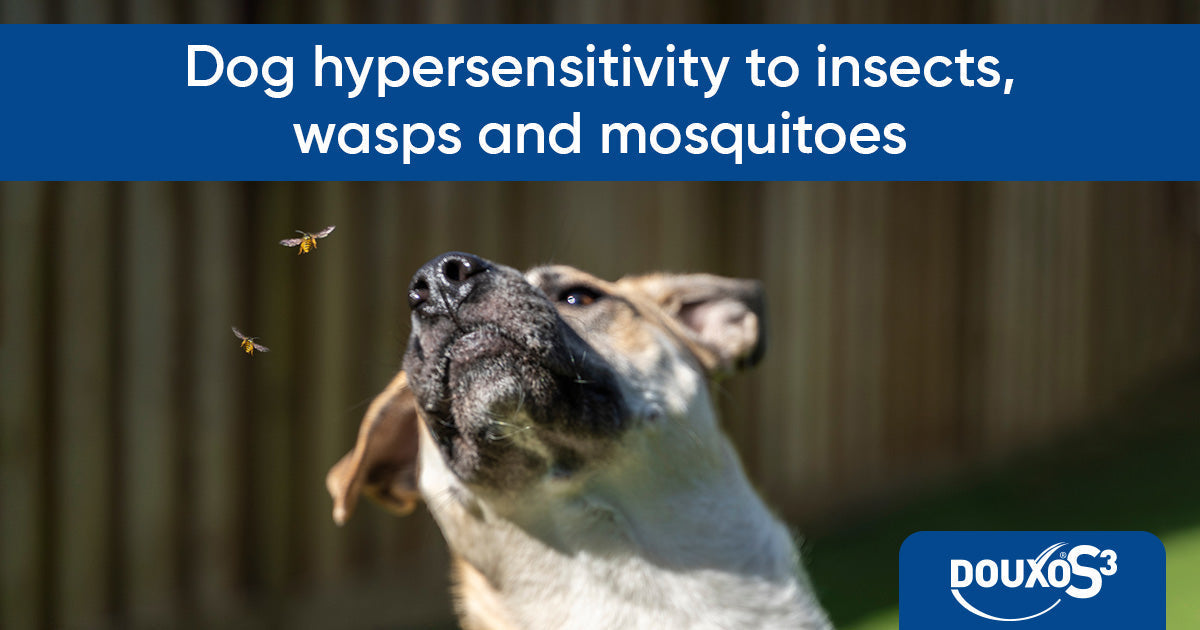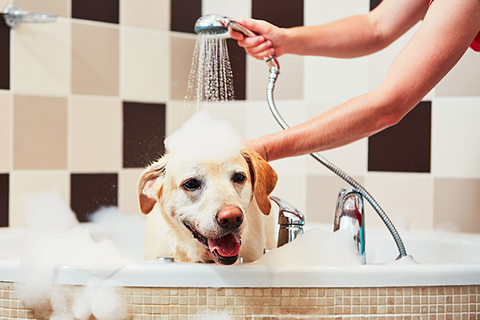
Dog hypersensitivity to insects: wasps and mosquitoes
Are your thoughts turning with the changing weather to picnics, camping, summer holidays, barbeques, and all kinds of outdoor living? The summer months can look inviting and idyllic, but unfortunately there are some downsides too. It’s the time of year when wasps, mosquitoes and other insects make their presence known.
Dogs can be very prone to getting bitten or stung, due to their highly exploratory natures, with noses and paws being most affected. As well as nosing around in bushes and streams, pets also have a tendency to chase flying, buzzing creatures - which can lead to trouble! Some dogs are unbothered by the odd insect bite, but others can be very sensitive to bites and stings and experience a range of uncomfortable symptoms.
What does insect hypersensitivity look like?
For all dogs, bites and stings can be painful. Immediately after the event, dogs may yelp or whine, and frantically lick, chew, or paw at the bitten areas. If stung on a foot, they may hold it up or limp. Most dogs will recover quickly from a bite or sting and return to normal.
However, those dogs who are especially sensitive will present a range of skin signs.
Classic symptoms of insect hypersensitivity include:
- Swelling and redness of the skin where bitten
- Skin is hot to the touch
- Lumps on the skin, or bumpy red rash (hives)
- Itching, licking, or scratching
Note the difference between this and other skin allergies
These signs are superficially similar to dogs with skin allergies (atopic dermatitis), such as to pollens and grasses. Atopic dogs are also more likely to struggle with their skin in the warmer months, due to the increase of allergens such as pollen. However, in cases of insect hypersensitivity the symptoms are likely to be more localised to the area of the bite or sting, and swellings or lumps are more commonly seen, due to inflammatory chemicals being released around the site. You may have even seen a wasp or mosquito near to your dog.
In some cases, dogs can be extremely allergic to wasp and bee stings
Anaphylaxis is thankfully rare, but in affected dogs, insect stings are one of the most frequently reported causes. If stung, affected dogs can have symptoms, such as difficulty breathing, swollen face or muzzle, vomiting and collapse. Swelling around the muzzle or nose is almost always an emergency, as if severe, the dog’s airway may be compromised. If you think your dog is having a severe allergic reaction, or one around the muzzle or nose, seek emergency veterinary attention.
Avoiding insect bites
Prevention is always better than cure! Mosquitoes not only leave a nasty bite, but they can carry disease, so keeping them well away from pets is always best where possible. Here are our top tips to keep dogs safe around insects.
- Distract dogs if they try and chase insects, and teach them the ‘leave’ command
- Avoid walking dogs near stagnant water, especially around dawn and dusk when mosquitoes are most active
- Keep homes and gardens free from food and stagnant water which may attract flying visitors
- Use a dog-safe insect repellent, and be careful if there are cats in the household, as many dog insect repellents contain permethrin which is harmful to felines.
Excitingly, trials are ongoing for a vaccine against wasp and mosquitoes’ allergens, aimed at providing broad protection against their bites and the associated dangers.
Treatment: minimising discomfort
In most cases, bites and stings will not be hugely harmful to dogs, but we all know that mosquito bites and wasp stings can be sore, itchy, and uncomfortable.
When dogs have sore and itchy skin, they naturally scratch and lick at it, which can actually perpetuate the damage. Excessive licking and scratching irritate and inflames the skin, leading to further skin problems such as moist dermatitis, ulcers, secondary infections and more.
It’s important to note that if your dog is showing signs of a severe reaction, you should seek veterinary advice urgently. Dogs having a severe allergic reaction will need medical treatment.
However, if your dog has a sting or bite and is showing only mild discomfort or reactions, there are steps you can take at home to minimise this.
Cold compresses
If you are on hand at the moment the bite or sting occurs, you can apply a cold compress to the affected area, using an ice pack. This will help reduce the swelling and inflammation, and deaden the itching, painful sensation.
Topical products
If there is discomfort, redness, swelling or a rash, topical treatments can help calm the skin, relieving your dog’s need to scratch and reducing the risk of infection. Products in the DOUXO® S3 CALM range include a soothing shampoo and mousse which can be applied across the body in cases of multiple bites or a large reaction. The handy pads can be used on small, specific areas in the case of a bite or sting which needs attention, without the need to shampoo the whole dog. These pads can be useful to have in a doggy ‘first aid kit’ on hand at home for just such occasions!
Conclusion
- Dogs can be sensitive to insect bites, with reactions including lumps and bumps, redness and itching
- Dogs scratch and lick at sore areas, which can make the irritation worse and predispose to infection
- Soothe skin with cold compresses and topical products, and keep pets inside at peak insect times as much as possible
















